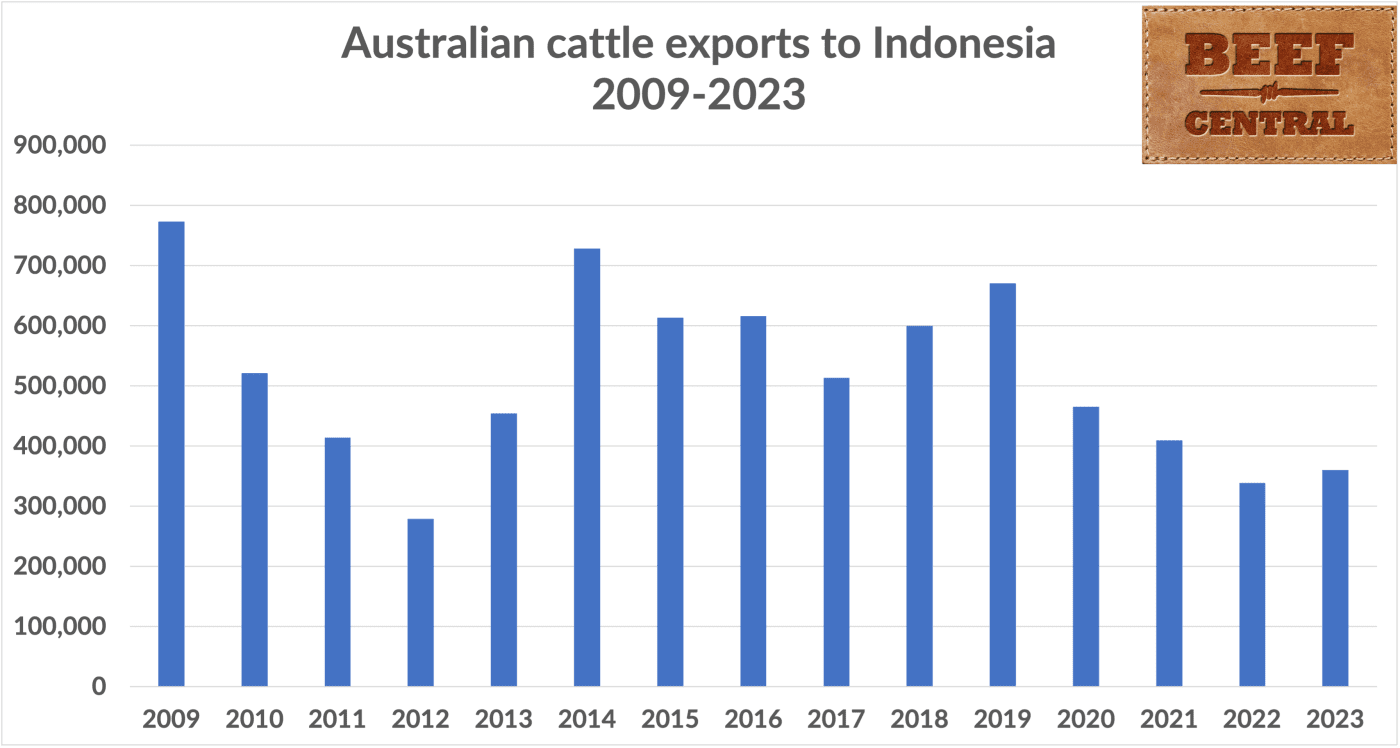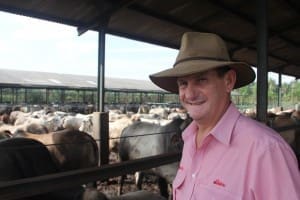Australian cattle exports to Indonesia averaged over 600,000 head per year between 2014 and 2019, before dropping to an average below 400,000 per year in the four years’ since.
Is this the new level, or is a return to trade volumes above 600,000 head likely again in future?
As the northern cattle industry gears up for the start of the annual dry season mustering rounds, Beef Central posed that question to several experts across the trade.
Their responses were mixed, but the general consensus was that export volumes are likely to return to 600,000 plus in the not-too-distant future – but probably not this year.
The trade has started 2024 on the backfoot following a seven-week delay in the release of import permits this year, and has been playing catch up since permits came out on February 16 in order to help Indonesian importers restock yards in time for the end of Ramadan feasting period and festivities early next month.
The decline in trade volumes since 2019 has been attributed to various factors including COVID disruptions to export logistics, economic conditions and consumer demand in major end markets, and coinciding high Australian cattle prices forced up by drought-depleted supply and strong demand from local restocker and feedlots for available stock.
The biggest single driver of the market for Australian cattle
Trying to get a feel for what lies ahead comes down largely to one primary factor, according to trade veteran Richard Slaney, who has spent many years in the trade between Australia and Indonesia.
“Indonesian policy is what really drives the market for Australian cattle,” he said,
“The base demand is there and rising, but over the years the key driver of numbers of cattle coming into Indonesia has been Government policy, either directly or indirectly.
“The Government of Indonesia has been forced to diversify their sources of beef, and they are doing that.”
There have been several examples over the years with quotas and weight limits, but perhaps the most impactful for Australia’s cattle trade to Indonesia in the past decade was the Indonesian Government decision to open its market to imports of cheaper frozen buffalo meat from India, which began arriving in the market in 2016. (First reported at the time by Dr Ross Ainsowrth on Beef Central)
IBM deeply embedded and ‘here to stay’
That element of trade is now a deeply entrenched source of meat supply in the Indonesian market, and one that is there to stay.
While the Indonesian Government was prepared to delay the release of import permits for a wide range of important food staples this year – rice, boxed beef and live cattle included – it was interesting to note that it immediately released permits for the import of 120,000 tonnes of Indian buffalo meat in early January – one of the very few import products prioritised.
Back-of-the-beer-coaster calculations suggest that about 100,000 tonnes of boxed Indian Buffalo Meat is equivalent to – and effectively displaces in the market – about 300,000 to 350,000 Australian feeder cattle.
Demand fundamentals still strong for Aus cattle
At the same time Australian cattle are still highly valued in the market for many reasons, including as a source of warm fresh beef which is still preferred by the many mum and dad Bakso ball makers which remain a major driver of base demand in Indonesian wet markets.
Indonesia has long wanted to build up its own herd, and newly elected president Prabowo Subianto is seen to be pro-agriculture and likely to prioritise policies designed to move Indonesia back towards self-sufficiency. He has already announced highly ambitious policies to increase dairy cow numbers from 0.5m to 2.5m to supply all school children with free milk.
Aus cattle exports help to stabilise Indonesia’s own herd
It may seem counter-intuitive but there is also said to be a strong understanding in Indonesia that Australian cattle imports are needed to help to protect local cattle herds from being severely eroded in periods of high beef demand.
When Australian cattle exports were stopped dead in their tracks for nine months during 1998 during the Asian Financial Crisis, the local cattle population was dramatically run down, which resulted in policies from regions such as Bali preventing female cattle being exported.
“They need the Australian cattle numbers to preserve their own herd numbers,” one source explained.
On that basis, some industry veterans told Beef Central they believe the trade has settled at a new level at current export volumes, and don’t expect to see annual Australian cattle exports lift much above the 400,000 head levels of annual trade now being experienced.
Another key question: How many cattle are there in Indonesia?
Another expert in the northern trade, Queensland Livestock Exporters Association president Greg Pankhurst, who has established world-class feedlots in Indonesia, said one key point is that little is really known about how many cattle are actually there.
Indonesia is the largest archipelago in the world with some 18,000 islands, including five main islands.
In recent years the Indonesian Government has estimated total herd numbers at around 18 million head.
But it now seems there may be far less.
Recent outbreaks of Foot and Mouth Disease and Lumpy Skin Disease have not only resulted in significant herd reductions, they have also led to more active surveys and scrutiny of cattle populations in order to assess numbers of vaccinations required.
As a result of that recent work, it is now suggested the real number of domestic cattle in Indonesia may be actually less than 12 million head.
Indonesia will need a lot more meat in future
If true, that means Indonesia, a country of more than 270 million beef-eating Muslims, will need a lot more meat from wherever it can get it.
Australia remains an important and reliable (albeit not withstanding the controversial snap 2011 suspension of cattle exports by Australia) source of supply.
Small changes can have big impacts on overall beef requirements
Mr Pankhurst also points out what a small upward change in per person beef consumption in a country like Indonesia would mean for beef demand in the country.
Per capita beef consumption in Indonesia is relatively low at around 2kg, compared to the South-East Asia average of 5kg.
And it is worth noting that is an average – among that number are the 20 percent of most affluent Indonesians who may eat as much as 10-15kg of beef per person per year and are continuing to want more meat in all its forms, while many less affluent may eat less than 1kg per year, and even less when prices rise high at the wet market.
Meat & Livestock Australia’s latest Indonesian market snapshot forecasts per capita beef consumption in Indonesia to grow at a rapid rate of about 11 percent year-on-year by 2025.
An extra 350 grams of meat per person per year across 270 million people could equate to a potential requirement of a further 400,000 to 500,000 head of cattle per year.
In Indonesia there are approximately 28 feedlots that range between 22,000 to 1000 head, which suggests that at any one time there could be a maximum of 220,000 cattle on feed.
Rising cost of feed hitting Indonesian feedlots
Another dynamic that could affect future demand is the rising costs of feed stocks in Indonesia.
The local cattle feeding industry has thrived for decades with access to cheaper waste by-products from other agricultural crops.
But with smarter processing more of that waste product now has uses and demand elsewhere.
The high price of corn has also reportedly led Indonesia’s massive chicken feeding industry to start looking at other feed sources, creating additional competition for cattle lot feeders.
“We have seen the feed cost really jump in the last six months, and that is putting some real pressure on feedlots,” Mr Pankhurst said.
High demand for beef in Indonesia should not be under-estimated
Troy Setter, CEO of Consolidated Pastoral Company which has large northern cattle stations in Australia and cattle feedlots in Indonesia, and chair of LiveCorp, believes that even with all of the cheaper Indian Buffalo Meat available, demand for meat in Indonesia will require strong levels of supply from Australia in future.
“There has obviously been large imports of IBM absolutely taking place, but there is 275 million people in Indonesia who are all eating more red meat,” he said.
“There has been a reduction in some of the domestic seafood production, chicken is more expensive to produce, and there have been changes in domestic beef production, so I think there is still space for both (Australian live cattle and Indian buffalo meat).”
Several factors point to growth ahead
Livestock exporter Tony Gooden from Frontier International Agri agreed that while Indian Buffalo Meat at the cheaper end of the market has displaced some demand for protein that would otherwise have been filled with beef from Australian cattle, overall population and economic growth supported strong demand for beef going forward.
He said he believes the market will return to volumes of 600,000 cattle per year in time, supported by a number of facts.
The domestic cattle herd in Indonesia has reduced; the human population of Indonesia is increasing, and annual growth is significant; GDP and hence buying power is increasing; a large Muslim population excludes pork as a competing cheaper protein; and Australian cattle prices are projected to remain steady trending lower as supply increases in the next one to three years.
Additionally, a post-COVID economic recovery is now occurring.
“Importantly the supply chain is economically compelling,” he said.
“As costs continue to increase in Australia, the model of exporting a commodity to a close South East Asian neighbour to value add is undeniably becoming more and more attractive.”








HAVE YOUR SAY